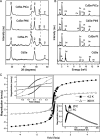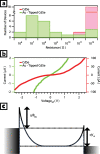Synthesis and characterization of hybrid nanostructures
- PMID: 22110873
- PMCID: PMC3215196
- DOI: 10.3402/nano.v2i0.5983
Synthesis and characterization of hybrid nanostructures
Abstract
There has been significant interest in the development of multicomponent nanocrystals formed by the assembly of two or more different materials with control over size, shape, composition, and spatial orientation. In particular, the selective growth of metals on the tips of semiconductor nanorods and wires can act to couple the electrical and optical properties of semiconductors with the unique properties of various metals. Here, we outline our progress on the solution-phase synthesis of metal-semiconductor heterojunctions formed by the growth of Au, Pt, or other binary catalytic metal systems on metal (Cd, Pb, Cu)-chalcogenide nanostructures. We show the ability to grow the metal on various shapes (spherical, rods, hexagonal prisms, and wires). Furthermore, manipulating the composition of the metal nanoparticles is also shown, where PtNi and PtCo alloys are our main focus. The magnetic and electrical properties of the developed hybrid nanostructures are shown.
Keywords: Electrical and magnetic properties; Hybrid Nanocrystals; MOCVD; Nanowires; synthesis.
Figures






Similar articles
-
Shape control of semiconductor and metal oxide nanocrystals through nonhydrolytic colloidal routes.Angew Chem Int Ed Engl. 2006 May 19;45(21):3414-39. doi: 10.1002/anie.200503821. Angew Chem Int Ed Engl. 2006. PMID: 16642516 Review.
-
Organic phase synthesis of noble metal-zinc chalcogenide core-shell nanostructures.J Colloid Interface Sci. 2016 Oct 15;480:159-165. doi: 10.1016/j.jcis.2016.07.015. Epub 2016 Jul 9. J Colloid Interface Sci. 2016. PMID: 27428852
-
Aggregate nanostructures of organic molecular materials.Acc Chem Res. 2010 Dec 21;43(12):1496-508. doi: 10.1021/ar100084y. Epub 2010 Oct 13. Acc Chem Res. 2010. PMID: 20942417
-
Colloidal branched semiconductor nanocrystals: state of the art and perspectives.Acc Chem Res. 2013 Jul 16;46(7):1387-96. doi: 10.1021/ar3002409. Epub 2013 Jan 31. Acc Chem Res. 2013. PMID: 23369428
-
Metal/Semiconductor hybrid nanostructures for plasmon-enhanced applications.Adv Mater. 2014 Aug 20;26(31):5274-309. doi: 10.1002/adma.201400203. Epub 2014 Apr 19. Adv Mater. 2014. PMID: 24753398 Review.
Cited by
-
Individual ZnO-Ag Hybrid Nanorods for Synergistic Fluorescence Enhancement Towards Highly Sensitive and Miniaturized Biodetection.Nanomaterials (Basel). 2025 Apr 17;15(8):617. doi: 10.3390/nano15080617. Nanomaterials (Basel). 2025. PMID: 40278482 Free PMC article.
-
Nanoimaging in cardiovascular diseases: Current state of the art.Indian J Med Res. 2015 Mar;141(3):285-98. doi: 10.4103/0971-5916.156557. Indian J Med Res. 2015. PMID: 25963489 Free PMC article. Review.
References
-
- Cozzoli PD, Pellegrino T, Manna L. Synthesis, properties and perspectives of hybrid nanocrystal structures. Chem Soc Rev. 2006;35:1195–208. - PubMed
-
- Peng X, Manna L, Yang W, Wickham J, Scher E, Kadavanich A, et al. Shape control of CdSe nanocrystals. Nature. 2000;404:59–61. - PubMed
-
- Subramanian V, Wolf EE, Kamat PV. Green emission to probe photoinduced charging events in ZnO-Au nanoparticles. Charge distribution and fermi-level equilibration. J Phys Chem B. 2003;107:7479–85.
-
- Pacholski C, Kornowski A, Weller H. Site-specific photodeposition of silver on ZnO nanorods. Angewandte Chemie Int Ed. 2004;43:4774–77. - PubMed
-
- Casavola M, Grillo V, Carlino E, Giannini C, Gozzo F, Fernandez E, et al. Topologically controlled growth of magnetic-metal-functionalized semiconductor oxide nanorods. Nano Lett. 2007;7:1386–95. - PubMed
LinkOut - more resources
Full Text Sources
Other Literature Sources
